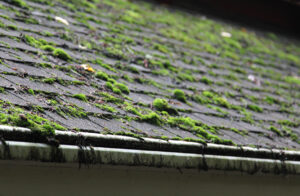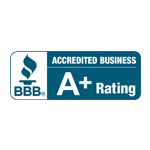Schedule A Free Estimate!
How to Prevent Moss on the Roof

Moss growing on a shingled roof
A lush, green carpet of moss might look charming on a forest floor, but it’s a sign of trouble when it appears on your roof. That velvety growth is more than just a cosmetic issue; it’s a living organism that traps moisture, which can lead to significant and costly damage over time. From rotting roof decking to compromised shingles, moss can shorten the lifespan of your roof and threaten the structural integrity of your home.
Understanding how to prevent moss is the key to protecting your investment. This guide will walk you through practical, actionable strategies to keep your roof clean, dry, and moss-free. We will cover everything from routine maintenance and landscape management to long-term prevention materials and eco-friendly solutions.
Why Moss is a Problem for Your Roof
Before diving into prevention, it’s important to understand why moss is such an unwelcome guest. Moss thrives in damp, shady environments, making north-facing roofs and homes surrounded by trees particularly vulnerable.
Here’s the damage it can cause:
- Water Damage: Moss acts like a sponge, absorbing and holding rainwater against your roofing materials. This constant moisture can seep under shingles, leading to rot in the underlying wood sheathing and potential leaks inside your home.
- Shingle Damage: As moss grows, its root-like structures (rhizoids) can lift and curl the edges of asphalt shingles. This makes them susceptible to being torn off by wind and rain, exposing your roof to the elements.
- Structural Strain: In colder climates, the water trapped by moss can freeze and expand. This freeze-thaw cycle can crack shingles, tiles, and other roofing materials, creating pathways for water to enter.
- Debris Buildup: Moss creates a dam that traps leaves, twigs, and other organic debris. This decomposing matter holds even more moisture and provides a fertile environment for more moss, mold, and algae to grow.
By taking proactive steps, you can avoid these problems and ensure your roof remains in excellent condition for years to come.
Proactive Prevention: Your First Line of Defense
The best way to deal with moss is to stop it from growing in the first place. An ounce of prevention truly is worth a pound of cure – and it’s much cheaper than a roof replacement.
Trim Overhanging Tree Branches
Sunlight and air circulation are moss’s worst enemies. Large trees with branches hanging over your roof create shade and drop leaves, providing the perfect cool, damp, and debris-rich environment for moss to flourish.
Make it a regular habit to trim back any branches that are within ten feet of your roofline. This simple landscaping task accomplishes three things:
- It allows more sunlight to reach your roof, helping it dry quickly after rain.
- It improves airflow over the roof surface, further aiding the drying process.
- It reduces the amount of leaves, acorns, and twigs that fall onto your roof and into your gutters.
Keep Your Roof Clean and Debris-Free
Organic debris is food for moss. At least twice a year – once in the late spring and again in the late fall – you should clear your roof of any accumulated leaves, pine needles, and sticks. You can use a leaf blower or a soft-bristle broom for this task. Never use a pressure washer, as the high-powered stream can strip away the protective granules on asphalt shingles and force water underneath them.
Ensure Gutters and Downspouts are Clear
Proper water drainage is critical for a healthy roof. Clogged gutters cause water to back up and overflow onto the roof’s edges, creating a perpetually damp area where moss loves to grow.
Clean your gutters at least twice a year. Check that your downspouts are clear and directing water away from your home’s foundation. If your gutters are consistently filling with debris, consider installing gutter guards as a low-maintenance solution.
Long-Term Solutions for Moss Prevention
While regular roof maintenance is essential, you can also incorporate materials that actively fight moss growth.
Install Zinc or Copper Strips
One of the most effective long-term strategies is to install metallic strips along the ridge of your roof. When it rains, water flows over these strips, picking up metal ions that are toxic to moss, algae, and lichens. This creates an environment where growth is inhibited.
- Zinc Strips: These are a popular and affordable option. They are installed just below the ridge cap on both sides of the roof peak. Over time, they create a protective barrier that keeps the roof clean.
- Copper Strips: Copper is slightly more expensive but is also highly effective. It works the same way as zinc and adds a distinct aesthetic to certain roof styles.
These strips are most effective on new or recently cleaned roofs. They are a preventative measure, not a solution for an existing, heavy moss problem.
Consider Moss-Resistant Shingles
If you are planning a roof replacement, ask your contractor about moss-resistant shingles. Many manufacturers now offer asphalt shingles infused with copper granules. These granules are slowly released over time with rainfall, providing continuous, built-in protection against algae and moss growth. While they may have a higher upfront cost, they can save you significant time and money on maintenance in the long run.
Eco-Friendly Moss Prevention Methods
Many homeowners prefer to avoid harsh chemicals. Fortunately, there are several effective, environmentally friendly options for preventing and treating moss.
DIY Prevention Sprays
You can create your own gentle, non-toxic sprays to inhibit moss growth. These solutions are best used as a preventative measure on a clean roof during a dry spell.
- Vinegar Solution: Mix equal parts white vinegar and water in a garden sprayer. Lightly spray the solution on areas prone to moss. The acetic acid in vinegar helps create an inhospitable pH level for moss.
- Baking Soda: Sprinkle baking soda lightly over the mossy areas and sweep it in. Baking soda is alkaline and will raise the pH, which can kill or deter moss. Rain will eventually wash it off.
Always test these solutions on a small, inconspicuous area first to ensure they don’t cause discoloration to your roofing materials.
Commercial Eco-Friendly Products
The market for green home maintenance products is growing. Look for moss killers and preventers that use potassium salts of fatty acids or other biodegradable ingredients as their active components. These products are effective at killing moss without harming surrounding plants, pets, or wildlife when used as directed.
When to Call a Professional
While many preventative tasks are suitable for a confident DIYer, working on a roof is inherently dangerous. If you are not comfortable with heights, have a particularly steep roof, or are dealing with a severe moss infestation, it is always best to hire a professional roofing company.
Professionals have the right safety equipment, training, and tools to handle the job safely and effectively. They can perform a thorough cleaning, assess for any underlying damage, and install long-term prevention systems like zinc strips.
Protect Your Roof, Protect Your Home
Your roof is one of the most important components of your home’s defense system. Allowing moss to take hold is a gamble that can lead to serious and expensive roof repairs. By being proactive – trimming trees, keeping your roof and gutters clean, and using preventative treatments – you can stop moss before it starts.
Take a look at your roof today. If you see the beginnings of green growth, take action now. A little effort will go a long way in preserving the life and integrity of your roof for many years.

